Arizona Elk Guides & Outfitters
ELK HUNTING
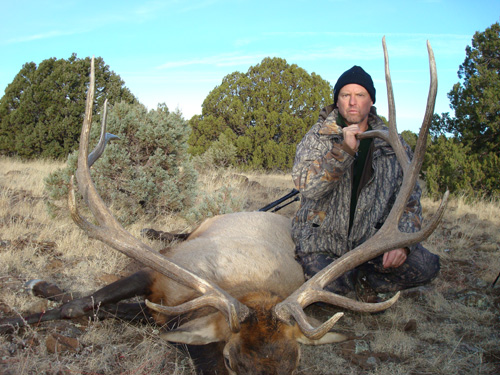
![]()
Arizona has some of the best elk hunting in the world and can be considered the top producer for record-class bulls! We offer a few great hunting options for elk enthusiasts from early rut firearms hunts, archery hunts, late firearms bull elk hunts and muzzleloader elk hunts.
Archery and Rut Firearms Bull Elk Hunts in Arizona
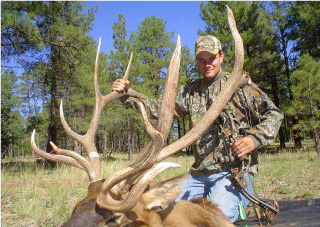 We
offer elk hunting primarily on the Coconino National Forest
with Flagstaff being the closest major city (sometimes other areas on a case by case basis). The most
popular elk hunting timeframe is during the rutting season when
bulls and cows are vocal. We conduct an archery rut hunt from mid to
late September and an early firearms/muzzleloader rut hunt at the
end of September through early October. This is the main part
of the rut, so there is usually nonstop action on these hunts. Bulls can fall victim to a call
during this timeframe. Nothing gets the blood pumping more than
hearing a monster bull elk answer your guide's calls. If luck is on
your side, the bull might come charging in for an opportunity to release
an arrow. Our archery
and early muzzleloader or early rifle elk hunts are conducted mostly
in higher timber elevations of 7000 to 8500 ft. Even though hunting
is done in September and October, the weather during these hunts are
very enjoyable. It can range from 65-75 degrees in the day to 35-45
degrees at night. Complimentary accommodations are in tent camps or
camping trailer, depending upon the number of hunters in camp and
feasibility. The camp and the hunt area is accessed by SUV or truck and hunting is done on foot. In most cases, elk live in mountainous
terrain, so hunters should be physically prepared. Hunters are encouraged to
condition themselves to the best of their ability in order to
increase their odds for success. If you are looking for a
horseback hunt, this is NOT the hunt for you. These three early
hunts are placed during the rut when elk are vocal.
We
offer elk hunting primarily on the Coconino National Forest
with Flagstaff being the closest major city (sometimes other areas on a case by case basis). The most
popular elk hunting timeframe is during the rutting season when
bulls and cows are vocal. We conduct an archery rut hunt from mid to
late September and an early firearms/muzzleloader rut hunt at the
end of September through early October. This is the main part
of the rut, so there is usually nonstop action on these hunts. Bulls can fall victim to a call
during this timeframe. Nothing gets the blood pumping more than
hearing a monster bull elk answer your guide's calls. If luck is on
your side, the bull might come charging in for an opportunity to release
an arrow. Our archery
and early muzzleloader or early rifle elk hunts are conducted mostly
in higher timber elevations of 7000 to 8500 ft. Even though hunting
is done in September and October, the weather during these hunts are
very enjoyable. It can range from 65-75 degrees in the day to 35-45
degrees at night. Complimentary accommodations are in tent camps or
camping trailer, depending upon the number of hunters in camp and
feasibility. The camp and the hunt area is accessed by SUV or truck and hunting is done on foot. In most cases, elk live in mountainous
terrain, so hunters should be physically prepared. Hunters are encouraged to
condition themselves to the best of their ability in order to
increase their odds for success. If you are looking for a
horseback hunt, this is NOT the hunt for you. These three early
hunts are placed during the rut when elk are vocal.
Arizona elk hunting is on a limited draw basis. Hunters must apply in January-February. The archery bull season is averaging 8 bonus points before the hunter draws. Some lucky guys are drawn for archery bull their first try, while others might take longer than 8. The key is to keep applying until drawn. The rut firearms tags are very high in demand and harder to draw than all the other elk hunts. But, if you draw the firearms rut tag, it is usually worth the decades of wait. Keep in mind that Non-Residents who do not have max points (around 28) have only a slim chance at ever drawing a RUT firearms tag. We suggest that nonresidents who want to hunt Arizona bull elk within the next couple decades, try to draw a more attainable tag, such as archery, late muzzleloader or late firearms seasons. The Arizona Elk draw period is late January-February, so contact us prior to the draw deadline for hunt number recommendations. Our rut archery bull elk hunters have typically experienced 100% Rate of Opportunity! Our past RUT early season firearms/muzzleloader hunters have experienced a 100% Success Rate with many of those rut firearms season bulls scoring 350" or more!
Our 2025 Early Bull Elk Season Dates:
Archery Bull: Sept. 12-25, 2025 for archery bull season
Rut Firearms Bull: Sept. 26 - Oct 2, 2025 for early rifle and early muzzleloader seasons
![]()
Late Firearms Season Bull Elk Hunts in Arizona
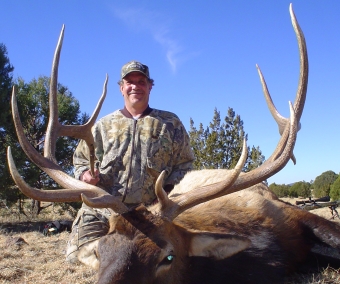 There
are two late firearms bull seasons, the late muzzleloader and late
rifle. We hunt late season elk primarily on the Coconino National Forest. The
Arizona late muzzleloader bull seasons have the best odds of drawing
a tag. The late rifle season has slightly lower odds, but still
fair. Since elk are somewhat migratory animals, cold weather combined
with frost or snow usually drives them out of the high country so
they can access the more palatable foods. This often brings them
into more open terrain with sparse trees and junipers. Mature
bulls typically will move to rougher canyons and segregate themselves from the cows during this
late season hunt. Since elk are not
vocal during this period, glassing vast distances from a high
vantage point is our main technique for the late season hunt. Once a good
bull is spotted, we get within shooting range. Expect long shots in
this fairly open, canyon country. If it snows in the higher
elevations just prior
to the late season and the weather cooperates, we can typically see an abundance of
bulls with more to choose from. If it
doesn't snow in the high country or it is dry with higher temps than
normal, the elk will not be concentrated. There still is a
chance at a good bull, but it only means we
must be persistent and hunt harder to find one. Elk live in mountainous
terrain, so hunters should be prepared. Hunters are encouraged to
condition themselves to the best of their ability in order to
increase their odds for success. If you are looking for a
horseback hunt, this is NOT the hunt for you.
There
are two late firearms bull seasons, the late muzzleloader and late
rifle. We hunt late season elk primarily on the Coconino National Forest. The
Arizona late muzzleloader bull seasons have the best odds of drawing
a tag. The late rifle season has slightly lower odds, but still
fair. Since elk are somewhat migratory animals, cold weather combined
with frost or snow usually drives them out of the high country so
they can access the more palatable foods. This often brings them
into more open terrain with sparse trees and junipers. Mature
bulls typically will move to rougher canyons and segregate themselves from the cows during this
late season hunt. Since elk are not
vocal during this period, glassing vast distances from a high
vantage point is our main technique for the late season hunt. Once a good
bull is spotted, we get within shooting range. Expect long shots in
this fairly open, canyon country. If it snows in the higher
elevations just prior
to the late season and the weather cooperates, we can typically see an abundance of
bulls with more to choose from. If it
doesn't snow in the high country or it is dry with higher temps than
normal, the elk will not be concentrated. There still is a
chance at a good bull, but it only means we
must be persistent and hunt harder to find one. Elk live in mountainous
terrain, so hunters should be prepared. Hunters are encouraged to
condition themselves to the best of their ability in order to
increase their odds for success. If you are looking for a
horseback hunt, this is NOT the hunt for you.
The weather during the later elk hunts can range from to 5-20 degrees at night to 40-60 degrees in the day. Snow is possible. Complimentary accommodations are in heated canvas tents with padded cots.
Late Bull Elk tags are also by draw in January-February. It is a much easier draw than the rut firearms bull season, but hunters are averaging 8 attempts before they draw a late bull elk tag. Some lucky hunters are drawn their first try, while unlucky applicants might take longer than 8. It's a random draw system, so the key is to keep applying until drawn. The Arizona Elk draw period is late January-February, so contact us prior to the draw deadline for hunt number recommendations. Our late firearms bull elk hunts consist of a late muzzleloader season and a late rifle season. Arizona Muzzleloaders can be modern "inline style" and use scopes and sabots. The late muzzleloader season has the highest odds of drawing a tag. Late bull elk hunts have a high rate of opportunity for taking shots.
Our 2025 Late Season Bull Elk Dates
Late Muzzleloader Bull Hunt: Nov 14-20, 2025
Late Rifle Bull Hunt (Arrive Thanksgiving): Nov 28 - Dec 4, 2025
![]()
ARIZONA ELK LICENSE AND TAG INFO
ALL OF OUR ARIZONA ELK HUNTING IS BY DRAW. The State of Arizona does not offer a landowner tag program. The Elk drawing online application starts in mid January with a deadline in early February. The applications for Arizona Elk are accepted Online at the AZGFD government website. Interested elk hunters should contact us as soon as possible. We can assist potential hunters who will be booking with us. You will be placed on a contacts list to receive an email with draw instructions and our recommended hunt numbers.
Arizona has a bonus point system which increases your odds of drawing a tag. Each time you are not drawn for a particular species, you receive a bonus point. Hunters can also choose not to apply and purchase a "bonus point only" instead. Points give you a better chance of obtaining a tag for future draws. Bonus points are becoming an essential part in successfully drawing Arizona elk tags.
License and Tag Fees
Arizona Elk Permit-Tag Fee
Resident: $148.00
Non-Resident: $665.00
Arizona Hunting License Fee
Resident: $37.00
Non-Resident: $160.00
Note: All draw applicants need to purchase a nonrefundable Arizona Hunting License in order to apply.
![]()
Our 2025 Arizona Elk Hunt
RATES
| Elk Hunt Options | # Days | Rate |
| Bull Elk Hunt (2 on 1) | up to 6* | $5,500.00/person |
| Bull Elk Hunt (1 on 1) | up to 6* | $6,500.00/person |
| RUT Firearms Bull Elk Hunt (1 on 1) | up to 6* | $7,500.00/person |
Choose a "Hunter to Guide Ratio" of either 1-on-1 or 2-on-1. The 1 on 1 rate means one hunter per guide. The 2 on 1 rate means two hunters per guide (share a guide). If choosing 2 on 1, you must bring the other hunter to share the guide with.
Non-Hunter Fee: Some hunters like to bring along a buddy to camp and share the experience while they hunt. There might be an option to invite one person as a non-hunter or observer while on your guided elk hunt. Non-hunter space is very limited. Based upon availability. Bull Elk Hunt Non-Hunter Fee: $1,500.00
* Hunters arrive in camp the day prior to hunting. The hunting ends around noon on the last day of the hunt. Hunters pack up and depart shortly thereafter. Hunters depart sooner if they tag out early. So, it's best if flying non-resident hunters arrive in Arizona the evening prior to meeting us (two days before hunting), rent an SUV from the airport, get a hotel room and we will meet the next day about noon in the hunt area. Flying hunters can follow us to camp in their rental vehicle. Flights should depart the morning after the hunt, since travel time from camp to the city could be lengthy. We hunt many areas across the State for elk. Therefore, depending upon which area you draw, a specified meeting spot and time will be arranged prior to the hunt. Our elk areas are about 2 to 4 hours from the Phoenix Airport or 4 to 5 hours from the Tucson Airport. These are the only major airports in Arizona. There are also a couple flights daily into the Flagstaff Airport in small planes from a few major cities. More details on the general info page.
Description of Our Elk Hunting Options:
Elk Hunts Include: complimentary tent camp accommodations, complimentary meals, a guide, skinning, packing out animal, and up to 6 days hunting. Choose a "Hunter to Guide Ratio" of either 1-on-1 or 2-on-1. The 1 on 1 rate means one hunter per guide. The 2 on 1 rate means two hunters per guide. If choosing 2 on 1, you must bring the other hunter to share the guide with.
 Accommodations:
Our complimentary accommodations are basic southwestern
style outfitter tent camps which are often located many miles from
civilization. Sleeping quarters for big game hunts are typically in
deluxe outfitter tents, unless noted otherwise. If you are looking for a hunt with fancy lodges, this is NOT the hunt for you!
Tent camps are used because we stay in remote areas. The
deluxe tents consist of large outfitter Kodiak Canvas brand tents. The size of our tents are tall and spacious
inside; typically 10X10 or 10X14 and stand 6.5 feet tall. The tents
are equipped with heaters during the colder months. Cots with thick
pads are provided, but all hunters must bring their own sleeping
bags. In most cases, hunters can bring their own camping trailer to
stay in, but we cannot discount the any hunt for doing so. It must
be high enough for ground clearance on rough dirt roads. Please ask
for road conditions before bringing one.
Video of our typical
camp.
Accommodations:
Our complimentary accommodations are basic southwestern
style outfitter tent camps which are often located many miles from
civilization. Sleeping quarters for big game hunts are typically in
deluxe outfitter tents, unless noted otherwise. If you are looking for a hunt with fancy lodges, this is NOT the hunt for you!
Tent camps are used because we stay in remote areas. The
deluxe tents consist of large outfitter Kodiak Canvas brand tents. The size of our tents are tall and spacious
inside; typically 10X10 or 10X14 and stand 6.5 feet tall. The tents
are equipped with heaters during the colder months. Cots with thick
pads are provided, but all hunters must bring their own sleeping
bags. In most cases, hunters can bring their own camping trailer to
stay in, but we cannot discount the any hunt for doing so. It must
be high enough for ground clearance on rough dirt roads. Please ask
for road conditions before bringing one.
Video of our typical
camp.
Hunters should note that Elk live in the rugged mountains and canyons. Hunters are encouraged to condition themselves to the best of their ability in order to increase their odds for success. We do not use or own horses and pack animals. If you are looking for a horseback hunt, this is NOT the hunt for you.
Expect long shots, since we hunt fairly open country. Archery hunters should be comfortable shooting out to 60 yards. Rifle hunters could encounter shots ranging from 150 to 500 yards. So, knowing the bullet drop is very important on this hunt. A bipod is a "must have" on rifle hunts, as well as a high-powered riflescope. Recommended rifle calibers for bull elk are the 7mm Magnums, .300 Magnums and .338 Magnums. Muzzleloader shots on elk could range from 60 yards to nearly 300 yards. Therefore, we recommend the modern Magnum inline muzzleloaders which can take a magnum charge of preferably 120 gr (vol) Blackhorn 209 loose powder or 150 gr Triple Seven pellets, use sabots, bipods and scopes. (ie. - T/C Omega, Triumph, CVA Paramount or Accura LR-X, Rem Ultimate Muzzleloader, etc.)
Additional Information
For those serious about booking a hunt, the first step is to apply for the draw during January through early February. Contact the outfitter for assistance with the drawing process. You will be given instructions on when, how and which areas to apply. If you draw a tag, we can then book the hunt with a minimum 50% nonrefundable deposit and a signed contract. The remaining balance is due at least 21 days prior to the hunt. We recommend cancellation insurance for all of our guests. Visit our policy page for more details.
Other Costs and Considerations that are the hunter's responsibility: Licenses and tags, transporting yourself to/from the camp, rental car, butchering, transporting of your meat/hide/trophy to your home, taxidermy, hotel stay before/after the hunt (if flying) are some other things to consider and are the hunter's responsibility. Gratuity for your guide is gladly accepted and is customary (15% is typical).
Non-Hunter Fee: Some hunters like to bring along a buddy to camp and share the experience while they hunt. There might be an option to invite one person as a non-hunter or observer while on your guided elk hunt. Non-hunter space is very limited. Based upon availability. Elk Hunt Non-Hunter Fee: $1,500.00
* Hunters arrive in camp the day prior to hunting. The hunting ends around noon on the last day of the hunt. Hunters pack up and depart shortly thereafter. Hunters depart sooner if they tag out early. So, it's best if flying non-resident hunters arrive in Arizona the evening prior to meeting us (two days before hunting), rent a car from the airport, get a hotel room and we will meet the next day about noon in the hunt area. Flying hunters can follow us to camp in their rental car. Flights should depart the morning after the hunt, since travel time from camp to the city could be lengthy. We hunt many areas across the State for elk. Therefore, depending upon which area you draw, a specified meeting spot and time will be arranged prior to the hunt. Our elk areas are about 2 to 4 hours from the Phoenix Airport or 4 to 5 hours from the Tucson Airport. These are the only major airports in Arizona. There are also a couple flights daily into the Flagstaff Airport in small planes from a few major cities. More details on the general info page.
![]()
Our Bull Elk Hunt Photos
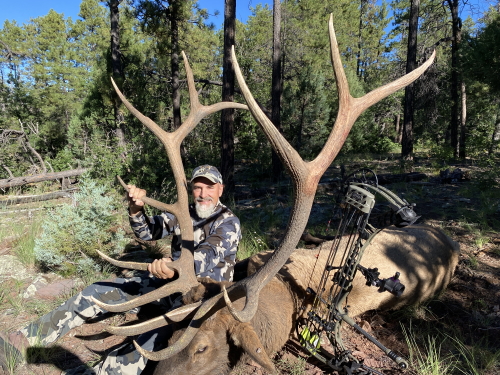
This magnificent 6a Arizona bull elk was called into 30 yards and Vic made a great shot with his bow

Congratulations to Jeff who tagged-out on this really nice bull elk during our late rifle season in 6a

This nice 6a bull came to a call during the archery rut season and Chuck made a good 50 yard shot

Nick from Ohio shot this outstanding Arizona bull elk with his muzzleloader at 225 yards during the late season in unit 6A
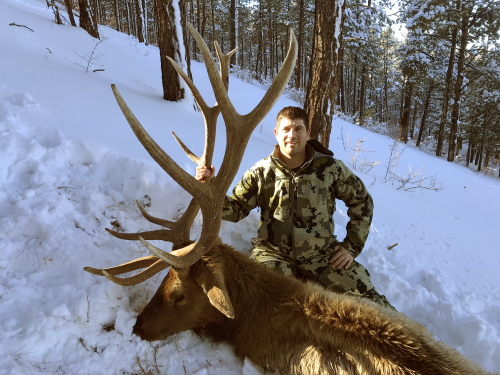
Thomas shot this nice late season bull elk at 383 yards one shot with his 28 Nosler

Mike with a nice bull elk that he shot during the late muzzleloader season in unit 6a
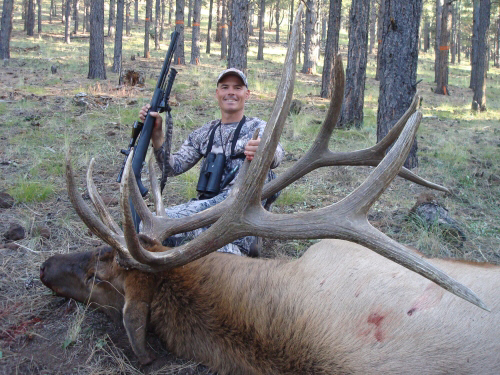
This giant early Muzzleloader Season bull elk was shot with a .50 caliber T/C Omega.
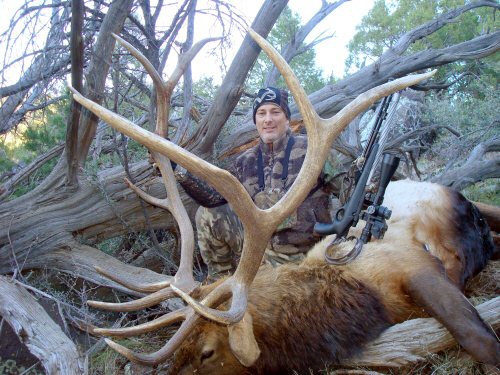
Anthony shot this giant Arizona bull elk with a scoped handgun at 246 yards in unit 6a
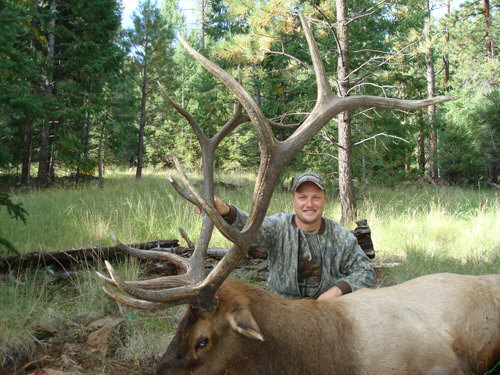
Eric from Michigan shot this big rutting Arizona Bull Elk after it was called into 40 yards

Twelve year-old Michael with an Arizona 6X6 bull elk that he shot at long distance using a .300 WSM in unit 6a

Ed with his Arizona 6x6 bull elk taken at 239 yards during the late muzzleloader season in unit 6a.
Be sure you visit our general info page to learn more about our operation.
![]()
